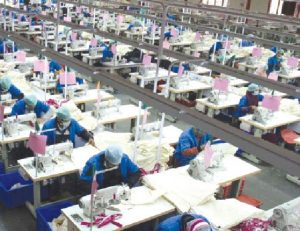 India’s share in the global textiles exports is just 5 per cent, which is minuscule as compared to China’s share of 38 per cent. Much smaller players like Bangladesh and Vietnam have a share of 3 per cent in global exports and are increasingly threatening India’s exports.
India’s share in the global textiles exports is just 5 per cent, which is minuscule as compared to China’s share of 38 per cent. Much smaller players like Bangladesh and Vietnam have a share of 3 per cent in global exports and are increasingly threatening India’s exports.
Estimated at $16.2 billion in the financial year 2019, India’s apparel exports fell by 1.2 per cent from the financial year 2018, which in turn was 4 per cent lower than the previous year. Even the share of apparel exports in the country’s total textile exports have fallen sharply from 51 per cent in the financial year 2017 to 45 per cent in the financial year 2019.
High input costs
Some of the issues that are holding the industry back include higher taxes, high cost of raw materials and cheap imports. The Northern India Textile Mills Association (NITMA) alleged that a multi-stage tax is levied on every value addition. State and central taxes, plus levies are resulting in Indian yarn becoming non-competitive in global markets. Then there was high cost of raw material.
Compared to its global competitors, Indian spinning mills have to spend more on raw materials, which directly affects their cost of production, and hence the country’s competitiveness in the global market. The cost of raw materials is much higher as compared to global prices, which results in a loss of 20-25 per kg to Indian mills. Also, the cotton-spinning industry has been hit by the cheaper import of garments and yarn from Bangladesh, Sri Lanka, and Indonesia. This is because of the lower cost of their raw materials as compared to India.
Textiles Mission okayed
It is in this context that the decision taken on February 26,2020 by the Cabinet Committee on Economic Affairs, chaired by the Prime Minister Narendra Modi can give much-needed relief to the ailing industry. The Cabinet Committee on Economic Affairs has given its approval to set up The National Technical Textiles Mission with a total outlay of 1480 crores, with a view to positioning the country as a global leader in Technical Textiles. The Mission would have a four-year implementation period from the financial year 2020-21 to 2023-24.
Technical Textiles are a futuristic and nice segment of textiles, which are used for various applications ranging from agriculture, roads, railway tracks, sportswear, health on one end to bullet proof jacket, fire proof jackets, high altitude combat gear and space applications on other end of the spectrum.
The Mission will have four components. The component of research, innovation, and development will have an outlay of 1000 crores. This component will promote both (i) fundamental research at the fibre level aiming at path-breaking technological products in Carbon Fibre, Aramid Fibre, Nylon Fibre, and Composites and (ii) application-based research in geo-textiles, agro-textiles, medical textiles, mobile textiles, and sports textiles and development of biodegradable technical textiles.
The fundamental research activities will be based on ‘pooled resource’ method and will be conducted in various Centre for Scientific and Industrial Research (CSIR) laboratories, Indian Institute of Technology (IIT) and other scientific/industrial/academic laboratories of repute. Application-based research will be conducted in CSIR, IIT, Research Design and Standards Organization (RDSO) of Indian Railways, Indian Council of Agricultural Research (ICAR), Defence Research & Development Organization (DRDO), National Aeronautical Laboratory (NAL), Indian Road Research Institute (IRRI) and other such reputed laboratories.
The component of promotion and market development would also be there. It says that the Indian Technical Textiles segment is estimated at USD 16 Billion, which is approximately 6 per cent of the 250 Billion USD global technical textiles market. The penetration level of technical textiles is low in India varying between 5-10 per cent against the level of 30-70 per cent in developed countries.
Mission targets
The Mission will aim at an average growth rate of 15-20 per cent per annum taking the level of domestic market size to 40-50 Billion USD by the year 2024; through market development, market promotion, international technical collaborations, investment promotions and ‘Make in India’ initiatives.
The third component relates to export promotion. This component aims at export promotion of technical textiles enhancing from the current annual value of approximately 14000 crores to 20000 crores by 2021-22 and ensuring 10 per cent average growth in exports per year upto 2023-24. Export Promotion Council for Technical Textiles will be set up for effective coordination and promotion activities in the segment.
Education, training and skill development would be given a lot of focus. It is observed that education, skill development and adequacy of human resources in the country are not adequate to meet the technologically challenging and fast-growing technical textiles segment. The Mission will promote technical education at higher engineering and technology levels related to technical textiles and its application areas covering engineering, medical, agriculture, aquaculture, and dairy segments.
Skill development will be promoted and an adequate pool of highly skilled manpower resources will be created for meeting the need for relatively sophisticated technical textiles manufacturing units. The Mission will focus on the usage of technical textiles in various flagship missions, programmes of the country including strategic sectors. The use of technical textiles in agriculture, aquaculture, dairy, and poultry. The JalJivan Mission; Swachch Bharat Mission; Ayushman Bharat will bring an overall improvement in cost economy, water and soil conservation, better agricultural productivity and higher income to farmers per acre of land holding in addition to the promotion of manufacturing and exports activities in India. The use of geo-textiles in highways, railways and ports will result in robust infrastructure, reduced maintenance cost and higher life cycle of the infrastructure assets.
Promotion of innovation amongst young engineering, technology, science standards, and graduates will be taken up by the Mission; along with creation of innovation and incubation centres and promotion of ‘start-up’ and Ventures’. The research output will be reposted with a ‘Trust’ with the Government for the easy and assessable proliferation of the knowledge thus gained through research innovation and development activities. A sub-component of the research will focus on the development of bio degradable technical textiles materials, particularly for agro-textiles, geo-texti!es, and medical textiles. It will also develop suitable equipment for environmentally sustainable disposal of used technical textiles, with emphasis on safe disposal of medical and hygiene wastes.
Mission’s mission
There is another important sub-component in the research activity aiming at the development of indigenous machinery and process equipment for technical textiles, in order to promote ‘Make In India’ and enable competitiveness of the industry by way of reduced capital costs. A Mission Directorate in the Ministry of Textiles headed by an eminent expert in the related field will be made operational. The Mission Directorate will not have any permanent employment and there will be no creation of building infrastructure for the Mission purpose. The Mission will move into the sunset phase after four years period.
The Cabinet Committee on Economic Affairs has observed that the technical textiles are textiles materials and products manufactured primarily for technical performance and functional properties rather than aesthetic characteristics. Technical Textiles products are divided into 12 broad categories (Agrotech, Buildtech, Clothtech, Geotech, Hometech, Indutech, Mobiltech, Meditech, Protech, Sportstech, Oekotech, Packtech) depending upon their application areas. India shares nearly 6 per cent of world market size of 250 Billion USD. However, the annual average growth of the segment is 12 per cent, as compared to 4 per cent world average growth. The penetration level of technical textiles is low in India at 5-10 per cent, against 30-70 per cent in advanced countries. The Mission aims at improving the penetration level of technical textiles in the country.
letters@tehelka.com












